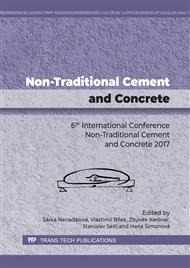[1]
R. Feret, Additions des matieres pulverulentes aux liants hydrauliquess, Annls Ponts Chauss 92 (1925) Paris.
Google Scholar
[2]
H. Y. Ghorab, A. M. K. Abdel Alim and O. M. Ahmed, Hardening characteristics of some clay minerals. Zement Kalk Gips, 11 (1991) 578-583.
Google Scholar
[3]
Calcined Clays for Sustainable Concrete: Proceedings of the 1st International Conference on Calcined Clays for Sustainable Concrete (2015).
DOI: 10.1007/978-94-017-9939-3_69
Google Scholar
[4]
Portland limestone calcined clay cement. Patent EP2253600A1. Publication date Ni 24, (2010).
Google Scholar
[5]
K. C. Thienel, N Beuntner, Ökologisch und technisch verbesserte Betone durch den Einsatz alternativer Zusatzstoffe: Nachhaltigkeit und Innovation. (2013).
Google Scholar
[6]
N. Beuntner - Innovationen in Beton–1. Leistungsfähigkeit großtechnisch calcinierter Tone und deren Wirksamkeit in zementären Systemen DAfStb-Jahrestagungmit. (2013)- unibw. de.
Google Scholar
[7]
M.P. Javellana, I. Jawed. Extraction of free lime in Portland cement and clinker by ethylene glycol. Cement and Concrete Research. 12 (1982) 399-403.
DOI: 10.1016/0008-8846(82)90088-6
Google Scholar
[8]
A. Yahia. M. Taminura, Y. Shimoyama, Rheological properties of highly flowable mortar containing limestone filler-effect of powder content and w/c ratio. Cement and Concrete Research 35 (3) (2005) 532–539. Doi org/10 016/ cemconres. 2004. 05 008.
DOI: 10.1016/j.cemconres.2004.05.008
Google Scholar
[9]
H.Y. Ghorab, I.M. Kenawi, Z. G. Abdel All, Interaction between cements and superplasticizers Materiales de Construccion 62 (307) (2012) 359-380.
Google Scholar
[10]
H. Basset, Notes on the system lime water on the determination of calcium. J. Chem. Soc. (1934) 1270-1275.
Google Scholar
[11]
R. Wiebe, V. L. Gaddy, The solubility of carbon dioxide in water at various temperatures from 12 to 40oC and at pressures to 500 atmospheres. Critical phenomena, J. Am. Chem. Soc., 62 (4) (1940) 815–817. DOI: 10. 1021/ja01861a033.
DOI: 10.1021/ja01861a033
Google Scholar
[12]
H. Y. Ghorab, F. Zahran, M. K. Mohamed. A. S. Meawad. On the durability of Portland limestone cement: effect of pH on the thaumasite formation HBRC Journal (accepted, in press).
DOI: 10.1016/j.hbrcj.2017.04.002
Google Scholar
[13]
M. K Mohamed, Investigations on the thaumasite formation in cement systems. M. Sc. Thesis. Helwan University Cairo Egypt. (2017).
Google Scholar
[14]
J. Bensted, Thaumasite–direct, woodfordite and other possible formation routes Cement and Concrete Composites. 25 (2003): 873–877.
DOI: 10.1016/s0958-9465(03)00115-x
Google Scholar
[15]
H.Y. Ghorab, A.M., Zayed, A.S. Mohamed, M.R. Mabrouk. The Formation of the ettringite from sulfate solutions. 12th International Congress on the Chemistry of Cement (ICCC). Montreal, Canada. (2007) W4-09. 3.
Google Scholar
[16]
A.S. Mohamed, Studies on the expansion behavior of the ettringite in pure systems and its application in cement mortars and concrete, M. Sc. Thesis, Helwan University Cairo Egypt (2006).
Google Scholar
[17]
H.Y. Ghorab; On the Chemistry of the Delayed Ettringite Formation, RILEM TC 186-ISA, Lausanne Switzerland, (2002), 65-71.
Google Scholar


